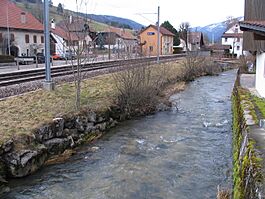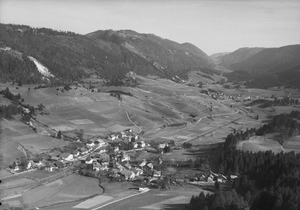Sorvilier facts for kids
Quick facts for kids
Sorvilier
|
||
|---|---|---|

The river Birs and the railroad station in Sorvilier
|
||
|
||
| Country | Switzerland | |
| Canton | Bern | |
| District | Jura bernois | |
| Area | ||
| • Total | 6.9 km2 (2.7 sq mi) | |
| Elevation | 681 m (2,234 ft) | |
| Population
(Dec 2020 )
|
||
| • Total | 283 | |
| • Density | 41.0/km2 (106.2/sq mi) | |
| Postal code |
2736
|
|
| Surrounded by | Bévilard, Champoz, Court BE, Romont, Péry | |
Sorvilier is a small town, also called a municipality, in Switzerland. It is located in the Jura bernois administrative district within the Bern canton. This area is known as the French-speaking Bernese Jura.
Contents
History of Sorvilier
Sorvilier was first mentioned a long time ago, in 1148. Back then, it was called Sorurvilier. Later, in 1179, it was known as Sororviler. It used to have a German name, Surbelen, but that name isn't used anymore.
For many years, Sorvilier was part of a region controlled by the Moutier-Grandval Abbey. This Abbey was part of the lands belonging to the Prince-Bishop of Basel. In 1531, Sorvilier adopted the new faith of the Protestant Reformation.
In 1773, a stone bridge was built over the Birs river. This bridge connected the main part of the village with the other side of the river. After the French won a war in 1797, Sorvilier became part of France. It joined the French region of Mont-Terrible. Three years later, in 1800, it became part of the Haut-Rhin region.
After Napoleon was defeated, Sorvilier was given to the Canton of Bern in 1815. This happened during the Congress of Vienna. In the mid-1800s, the watchmaking industry started in the village. In 1877, a railroad opened a station in Sorvilier. This helped the growing watch industry by connecting it to more suppliers and customers. By 1900, about 100 people worked making watches and watch parts. At that time, the village had a population of 438.
Geography and Location
Sorvilier covers an area of about 7.02 square kilometers (2.71 square miles). A large part of this land, about 45.7%, is used for farming. Forests cover almost half of the area, about 48.9%. Buildings and roads make up about 3.5% of the land. Rivers and lakes cover about 0.7%, and a small part, 0.4%, is unproductive land.
The village is located in the Tavannes valley. It sits on both sides of the Birs river.
Some nearby towns, like Bévilard and Court, are thinking about joining together with Sorvilier. This new, larger municipality would be called Valbirse.
Sorvilier's Coat of Arms
The coat of arms for Sorvilier has a special design. It shows two red ears of grain with green leaves. These grow from a green hill with three rounded tops. Above them, there is a red star.
People of Sorvilier
Sorvilier has a population of 266 people (as of December 2011). About 8% of the people living here are foreign nationals. Over the last ten years (2001-2011), the population has changed a little, growing by about 1.1%.
Most people in Sorvilier speak French as their main language. About 90.4% of the population speaks French. German is the second most common language, spoken by about 7% of the people. A small number of people, about 1.1%, speak Albanian.
In 2008, about 51.7% of the population was male, and 48.3% was female. Most of the people living in Sorvilier were born in Switzerland. About 34.9% were born right in Sorvilier.
In 2011, children and teenagers (ages 0–19) made up about 19.9% of the population. Adults (ages 20–64) made up 60.9%. Older adults (over 64 years old) made up 19.2%.
The chart below shows how the population of Sorvilier has changed over time:

Economy and Jobs
In 2011, Sorvilier had a low unemployment rate of 1.42%. In 2008, 68 people worked in the municipality.
Jobs in Sorvilier are divided into three main types:
- Primary sector: This includes jobs like farming. There were 25 people working in this area.
- Secondary sector: This includes jobs like manufacturing (making things) and construction. There were 13 people working in this area.
- Tertiary sector: This includes jobs that provide services, like sales, restaurants, education, and healthcare. There were 30 people working in this area.
Many people who live in Sorvilier also work there. In 2000, 50 workers (about 75.8% of all workers in the municipality) both lived and worked in Sorvilier. However, more people leave Sorvilier to work elsewhere than come into Sorvilier for work.
Most people get to work using a private car (64.2%). About 10.8% use public transportation.
Religion in Sorvilier
Based on a 2000 survey, most people in Sorvilier belong to the Swiss Reformed Church (56.6%). About 16.9% are Roman Catholic. Some people belong to other Christian churches (6.62%) or are Islamic (2.94%). A small number of people are Buddhist or belong to other religions. About 12.5% of the population said they did not belong to any church or were agnostic or atheist.
Education in Sorvilier
In Sorvilier, about 61.4% of adults have finished upper secondary education. This is schooling after primary school that is not required. About 7.1% have completed even higher education, like a university.
The school system in the Canton of Bern starts with one year of optional Kindergarten. After that, students go to six years of Primary school. Then, they have three years of required lower Secondary school. In secondary school, students are grouped by their abilities. After lower Secondary, students can continue their education or start an apprenticeship (learning a trade).
During the 2011-2012 school year, 17 students attended primary school in Sorvilier. There were no kindergarten classes in the municipality. About 17.6% of the primary students spoke a different language at home than the language used in the classroom.
In 2000, all 17 students who attended school in Sorvilier also lived there. However, 19 students who lived in Sorvilier went to schools outside the municipality.
Transportation
Sorvilier has its own railway station, called Sorvilier. This station is on the Sonceboz-Sombeval–Moutier line. Trains regularly travel from Sorvilier to Biel/Bienne and Moutier.
See also
 In Spanish: Sorvilier para niños
In Spanish: Sorvilier para niños





